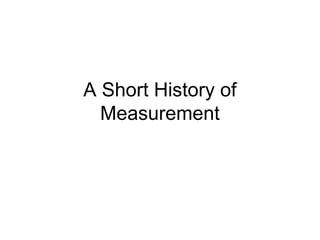
historyofmeasurements-150621094720-lva1-app6891.pdf
- 1. A Short History of Measurement
- 2. Cubit Cubit was used by Egyptians for building pyramids (2750 B.C.) Mean error in length of sides of Khufu Pyramid at Gizeh in Eqypt was 1.5mm The ‘Cubit’ was the first recorded standard linear measurement. Defined by the distance from the tip of the forefinger to the middle of the elbow
- 3. Hand The Height of a horse is still measured in hands today. 1 hand = 4 inches = 101.6mm The Cubit was subdivided into several other measurements. One hand is measured with the fingers closed and from end of the thumb to the other end of the palm
- 4. Foot Today 1 Foot = 12 inches = 304.8 mm History believes that the foot was given its name from the human body part. The length of a human foot was measured from the heel to the tip of the big toe. From Egyptians through the Greeks and Romans to present day the length of one foot has increased considerably. This is caused by the use of the foot in building and as time developed the use of measuring with boots on feet has increased the size of one foot
- 5. History of the International Systems of Units (SI) 1799 - French Revolution and the subsequent deposition of two platinum standards representing the meter and the kilogram, on 22 June 1799, in the Archives de la République in Paris 1832 - Gauss promoted using the Metric System. Gauss was the first to make absolute measurements of the earth’s magnetic force in terms of a decimal system based on the three mechanical units millimetre, gram and second for, respectively, the quantities length, mass and time.
- 6. History of the International Systems of Units (SI) cont. 1860 - Maxwell and Thomson further developed Gauss’s work through the British Association for the Advancement of Science (BAAS). They formulated the requirement for a coherent system of units with base units and derived units. 1874 - BAAS introduced the centimetre-gram- second (CGS) system, a three-dimensional coherent unit system based on the three mechanical units centimetre, gram and second, using prefixes ranging from micro to mega to express decimal submultiples and multiples. The following development of physics as an experimental science was largely based on this system.
- 7. History of the International Systems of Units (SI) cont. 1880s - BAAS added the ohm for electrical resistance, the volt for electromotive force, and the ampere for electric current in conjunction with International Electrical Congress . May, 20 1875 - After the establishment of the Meter convention the International Committee for Weights and Measures (ICPM) concentrated on the construction of new prototypes taking the meter and kilogram as the base units of length and mass. In 1889 the 1st General Conference on Weights and Measures (CGPM) sanctioned the international prototypes for the meter and the kilogram. Together with the astronomical second as unit of time, these units constituted a three-dimensional mechanical unit system similar to the CGS system, but with the base units meter, kilogram and second.
- 8. History of the International Systems of Units (SI) cont. 1901 – Giovanni Giorgi a very successful Italian Scientist and Engineer showed that it is possible to combine the mechanical units of this meter–kilogram–second system with the practical electric units to form a single coherent four- dimensional system. Giorgi’s proposal opened the path to a number of new developments 1921 - Giorgi proposal was thoroughly discussed by the several international organizations. 1939-1946 The discussions led to the adoption of a four-dimensional system based on the meter, kilogram, second and ampere, the proposal was approved in 1946
- 9. 1971 - the current version of the SI was completed by adding the mole as base unit for amount of substance, bringing the total number of base units to seven. 1954 - The introduction of the ampere, the Kelvin and the candela as base units, respectively, for electric current, thermodynamic temperature and luminous intensity. 1960 - The name International System of Units (SI) was given to the system History of the International Systems of Units (SI) cont. The ampere is officially defined as “the current in a pair of equally long, parallel, straight wires 1 meter apart that produces a force of 0.0000002 Newton's (2 × 10−7 N) between the wires for each meter of their length” The Kelvin is officially defined as “A temperature scale in which zero occurs at absolute zero and each degree equals one Kelvin. Water freezes at 273.15 K and boils at 373.15 K.” The Candela is officially defined as “A unit of luminous intensity equal to 1/60 of the luminous intensity per square centimetre of a blackbody radiating at the temperature of solidification of platinum (2,046°K).” The mole is officially defined as “The mass in grams of this amount of a substance, numerically equal to the molecular weight of the substance.”
- 10. SI Units NPLS Beginners Guide to measurement (2010)
- 11. Si Units
- 12. Quantity Unit Symbol Length Metre m Mass Kilogram kg Time Second s Area Squared metre m2 Solids volume Cubic metre m3 Liquid volume Litre L=10-3 m3 Velocity Metre per second m/s Acceleration Metre per second squared (m/s2 ) Angle Radian rad Angular velocity Radian per second rad/s Angular acceleration Radians per second squared rad/s2 Density Kilogram per cubic metre kg/m3 Force Newton N = kgm/s2 Moment of force Newton-metre Nm Stress and Pressure Pascal Pa = N/m2 Frequency Hertz Hz = cycle/s Impulse Newton-second Ns Work Joule J = Nm Power Watt W=j/s Thermal Conductivity Watt per metre per degree centigrade W/m°C Specific heat Joule per Kilogram per degree centigrade J/kg°C Convection film coefficient Watt per metre squared per degree centigrade W/m2 °C Heat Power Watt W Heat Flux (heat generation per area) Watt per metre squared W/m2
- 13. Examples of modern measurement tools